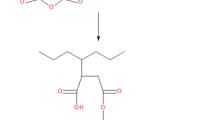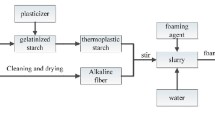Abstract
In this study, thermo-compression molding was used to fabricate bulk materials from native starch powder. The objective was to determine the process parameters that enabled the welding of starch granules while preserving their crystallinity. The effects of forming parameters such as temperature, compression stress, and water content on the microstructural and mechanical properties of the starch samples were studied. For the optimal forming conditions, good compaction and cohesion of starch granules were obtained, while successfully preserving their native crystalline structure. The flexural Young’s modulus of the best samples reached an average value of 3 GPa and the flexural strength reached 10 MPa. However, these materials also exhibited unwanted cracks. The potential origin of these defects was associated to the heterogeneous distribution of water during processing as well as thermal shrinkage, moisture uptake, and viscoelastic recovery that occurred after the mold ejection.














Similar content being viewed by others
References
Schroeter J, Hobelsberger M (1992) On the mechanical properties of native starch granules. Starch 44:247–252
Buléon A, Potocki-Véronèse G, Putaux J-L (2007) Self-association and crystallization of amylose. Aust J Chem 60:706–718
Salerno M, Żukowska A, Thorat S, Ruffilli R, Stasiak M, Molenda M (2014) High resolution imaging of native wheat and potato starch granules based on local mechanical contrast. J Food Eng 128:96–102
Ceseracciu L, Heredia-Guerrero JA, Dante S, Athanassiou A, Bayer IS (2015) Robust and biodegradable elastomers based on corn starch and polydimethylsiloxane (PDMS). ACS Appl Mater Interfaces 7:3742–3753
Yu L, Christie G (2000) Measurement of starch thermal transitions using differential scanning calorimetry. Carbohydr Polym 46:179–184
Donovan JW (1979) Phase transitions of the starch-water system. Biopolymers 18:263–275
Biliaderis CG, Page CM, Maurice TJ, Juliano BO (1986) Thermal characterization of rice starches: a polymeric approach to phase transitions of granular starch. J Agric Food Chem 34:6–14
Day L, Fayet C, Homer S (2013) Effect of NaCl on the thermal behaviour of wheat starch in excess and limited water. Carbohydr Polym 94:31–37
Biliaderis CG (2009) Structural transitions and related physical properties of starch. In: BeMiller J, Whistler R (eds) Starch—chemistry and technology. Academic Press, Thessaloniki, pp 293–372
Dello SAWG, van Dam RM, Slangen JJG, van de Poll MCG, Bemelmans MHA, Greve JWWM, Beets-Tan RGH, Wigmore SJ, Dejong CHC (2007) Liver volumetry plug and play: do it yourself with ImageJ. World J Surg 31:2215–2221
Fayolle B, Verdu J (2005) Vieillissement Physique des Matériaux Polymères, Techniques de l’Ingénieur Propriétés Générales des Plastiques AM3150:1–19
Gebhardt R, Hanfland M, Mezouar M, Riekel C (2007) High-pressure potato starch granule gelatinization: synchrotron radiation Micro-SAXS/WAXS using a diamond anvil cell. Biomacromolecules 8:2092–2097
Lozano JE, Rotstein E, Urbicain MJ (1983) Shrinkage, porosity and bulk density of foodstuffs at changing moisture contents. J Food Sci 48:1497–1502
Millauer C, Rosa G, Schär R (1987) Determination of the density of starches and cereal products as a function of temperature and pressure. In: Meuser F, Manners DJ, Seibel W (eds) Plant polymeric carbohydrates. Woodhead Publishing, Cambridge, pp 86–103
Nishiyama Y, Putaux J-L, Montesanti N, Hazemann J-L, Rochas C (2010) B → A allomorphic transition in native starch and amylose spherocrystals monitored by in situ synchrotron X-ray diffraction. Biomacromolecules 11:76–87
Acknowledgements
The authors gratefully acknowledge Institut Carnot PolyNat for funding this study. Besides, they would like to thank S. Rolland du Roscoat, P. Charrier, B. Khelifi, D. Curtil, R. Passas, C. Sillard, and S. Dufreney for their technical support, as well as R. Léger from Centre des Matériaux des Mines d’Alès (C2MA) at École des mines d’Alès for assistance with pycnometer experiments. The LGP2 and 3SR laboratories are part of LabEx Tec 21 (Investissements d’Avenir—Grant Agreement No. ANR-11-LABX-0030).
Author information
Authors and Affiliations
Corresponding author
Rights and permissions
About this article
Cite this article
Regazzi, A., Dumont, P.J.J., Harthong, B. et al. Effectiveness of thermo-compression for manufacturing native starch bulk materials. J Mater Sci 51, 5146–5159 (2016). https://doi.org/10.1007/s10853-016-9817-7
Received:
Accepted:
Published:
Issue Date:
DOI: https://doi.org/10.1007/s10853-016-9817-7




